Studio Ghibli
Introduction
To properly analyze the popularity of Studio Ghibli, we conducted a short survey. Here, we will briefly discuss our method and our results.
Starting with a bit of brainstorming, we took to the drawing board and began focusing on relevant questions for our research. After deciding which questions we wanted to ask, we began thinking about our audience. Would it just be Japanology students, like us. Or did we want to expand to a bigger audience. In the end we decided on the latter, which turned out to be a great success with 267 people participating.
As for the results, we will start by giving a short outline. The details together with the conclusion will be explained in the research itself.
The survey started off with the essential questions, like age and gender. Here however it was noticeable that the participants were mostly female (about 60 %) which will have an impact on the questions related to gender.
From then on popularity became our main focal point. Did you know about Ghibli beforehand? Which films did you watch? How did you become familiar with Ghibli?... , etc. Looking at the answers, we were actually somewhat surprised. Despite our audience being 50% adults who are not currently studying at a university, more people were familiar with Ghibli then not. So in our research we examine why this studio has gathered such enormous popularity and what makes it so attractive.
Lastly, we asked the question: "do you prefer a male or a female protagonist?", while most people answered: "I don't know", the next largest group of participants actually chose "female". In the gender related part of our research we delve deeper into the abundance of female protagonists of Miyazaki and why this seems to be such a popular choice.
With a special thanks to professor Deborah Giustini for her kind feedback and to professor Hans Coppens for his guidance.
OpenRefine
As it is going to be mentioned, it is undeniable that the main roles in animated films are mostly given to male characters. If the main role is given to a female character, she is more likely to be in a defenseless position. This phenomenon is not only present in the film industry but also in our daily lives, such as games and comics. One of the more popular examples is the \'Mario-games\' series where the main hero, Mario, has to go rescue the princess, Peach, countless times. Further research of gender, beyond game characters is necessary.
This research is based on an online survey conducted by us, the authors, and data from the website \'My anime list\', which is very well known among anime lovers.
We argue that people who identify as women are more likely to choose films with a female protagonist than with a male protagonist, this also applies to people who identify as men and male protagonists. That is why we mainly focus on what gender the participants were and whether they preferred male or female protagonists.
Data Mining was one of the methods we had to work with to complete this research; we had to take the data we collected on \'My anime list\' about Ghibli-films and put them into OpenRefine. (Open refine is a free-to-use tool for organizing messy data; where you analyze, explore, clean and match your data.)
From the 54 products Studio Ghibli produced known on \'My anime list\', we had to collect which score they were attributed to, the number of users who saw the films, and what gender the protagonist was.
Once the results from the survey came back, those were put into Openrefine as well. This made the comparison with the collected data from \'My anime list\' and the collected data from the survey much easier.
The number of participants who already knew about Studio Ghibli before making the survey were 173 participants from a total of 267. Out of those 173; 59% were women, 38.7% were men and the remaining 2.3% did not want to reveal their gender.
The findings show that 44 participants from the 173 preferred female to male protagonists, 7 male to female, and 122 didn\'t know or couldn\'t choose. As expected, 86.4% of female participants chose a female protagonist, and 85.6% male participants chose a male protagonist.
Studio Ghibli and its ever-growing popularity
Studio Ghibli can attribute its popularity to a number of things. Many of these things are also present in other animation films, but Studio Ghibli takes it to the next level, giving these elements a unique feel. These unique elements are what people love about Studio Ghibli films and are the reason why the fan base is ever-growing. To better comprehend this, we will delve deeper into the answers form our survey.
The participants were between the age of 18 and 60 years old. Since we know that more than 50% is familiar with Studio Ghibli, we can conclude that it is something that is enjoyed by all age groups.
When it comes to discovering Studio Ghibli, it appears that young teenagers are more likely to come in contact with the films.
We asked the participants the question 'What do you like about the Studio Ghibli films?'. The most common reason given had something to do with the artistic component of the films. The answers used words like 'animation', 'drawing', etc... Studio Ghibli has even published "The art of...' books for a number of their films. Their ratings are very high, and they have been reviewed by many people. As you can see from the photo's taken from Goodreads.com, these artbooks have an average rating of 4.5/5 and higher.
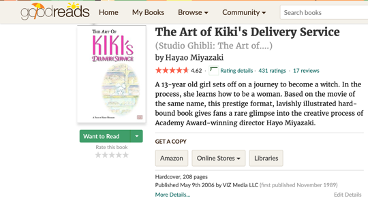
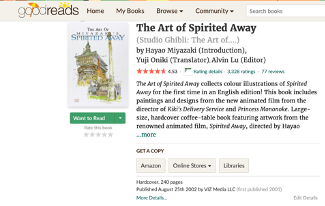

(Source: https://www.goodreads.com/author/list/4263.Hayao_Miyazaki)
The popularity of the artwork created by Studio Ghibli is also visible through the vast amount of people that recreate the characters and scenes in their own style (fanart). These fanarts are shared between Ghibli lovers on various different platforms, for example Facebook, Twitter, Pinterest, etc...
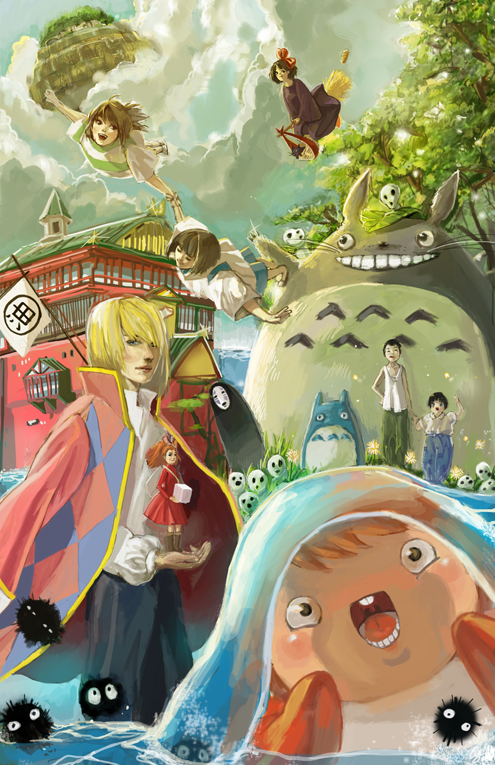
(Source picture: https://imgur.com/gDpBPYA?r)
The second most popular element was the story-element. People mentioned the settings, the happenings but also the fantasy and the folklore elements that are incorporated into each of the Ghibli productions. Many of the films are based on already established books or stories, but Hayao Miyazaki and his company gave them their own twists, making new unique stories. For example, the film Arrietty was based on the beloved book The Borrowers by Mary Norton. While the film keeps enough of the original idea for the audience to recognize, it still has its own unique style. Howl's Moving castle is another one of Studio Ghibli's (beloved) films that borrowed the original idea from a book written by Dianna Wynne Jones.
Folklore and fantasy were also common answers among the responders to our survey. The films with the most prominent show of Japanese folklore and with the highest popularity are probably Spirited Away and Mononoke-hime. To give an example, the character Haku from Spirited Away is based on a type of river dragon/serpent from Japanese folklore, called a Mizuchi.
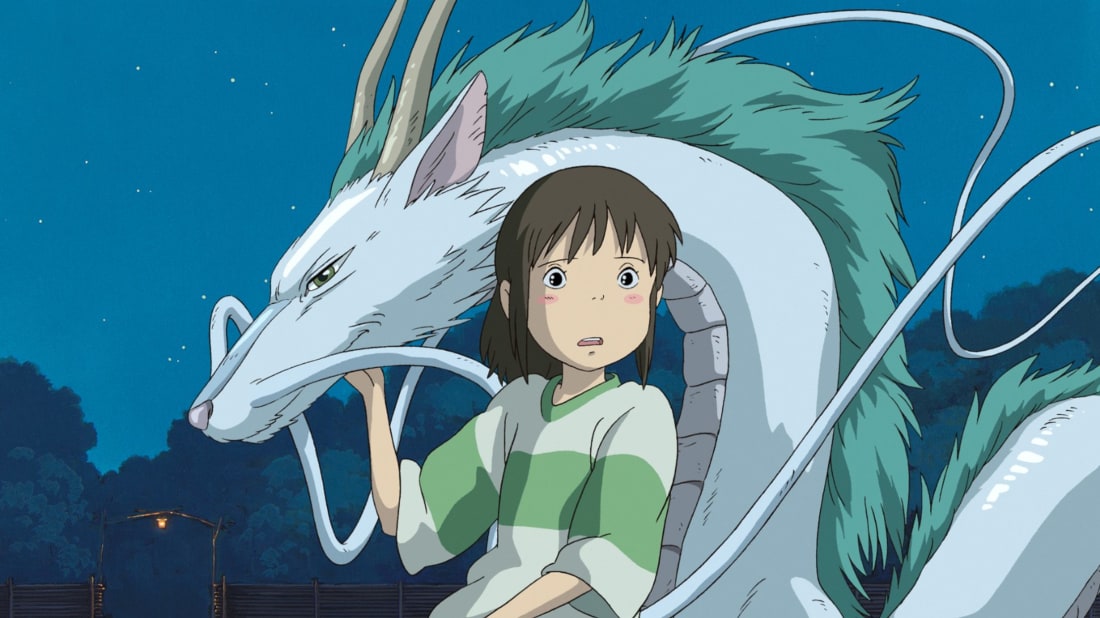
(Source picture: https://www.mentalfloss.com/article/60237/15-fascinating-facts-about-spirited-away)
Although many respondents claimed to love the 'childish-ness' and 'innocence' of Studio Ghibli productions, many also stated they enjoyed the presence of a hidden message or moral. This is why Studio Ghibli has fans in many different age categories, they can be appreciated at different levels at different times in your life.
Another reason is their wide range of topics. You have fantasy films like Spirited away and My Neighbor Totoro. More action-based films like Castle in the Sky. Or even films about normal everyday life such as From Upon Poppy Hill and The Wind Rises. They simply have something for everyone to enjoy.
The films are like a fresh breeze, they are more slow-paced than the typical Western animation films. There is also no need for a hero or a villain to make the story interesting.
Ghibli's films play in on our emotions, something they excel at. They can make you happy, sad, curious, and amazed, sometimes all at the same time. All these emotions that you feel makes the story so much stronger and make empathizing with the characters effortless.
The different characters and the relationships between them are also a reason why these films are so enjoyable. Most of the time, the characters are normal people and because of this you can relate to them in at least one way or another.
This makes watching them so much fun as you can imagine yourself in their place. While watching them grow, you want to learn more about them, you become attached in some way.
The strong bonds of friendship and love between the characters make it exciting to watch how those relationships unfold throughout the story. They are real bonds that occur in real life, allowing the viewer to relate to the characters, making it so enjoyable to watch.
The last question we asked was if the respondents watched animated films from other studios. We asked this in order to see who the main competitors of Ghibli are. Most people answered, Walt Disney Animation Studios and Pixar Animation Studios, which are Western studios.
However, a few other Japanese animation studios were also mentioned. The most popular ones were Madhouse and Toei Animation. The survey also showed that a very small percentage of the participants claimed to not watch films from any other animation studio, which is interesting.
In an article written in 2019, a film industry and review website, Indie Wire, asked 23 film critics which animation studio they found better: Studio Ghibli or Pixar Animation Studios. 16 of the film critics found Studio Ghibli to be better. These were some of their arguments in favor of Studio Ghibli:
"Each of their monuments to imagination and craft blends hand-painted backgrounds with rigorously animated characters to convey philosophically intricate tales of wonder" (Carlos Aguilar)
"There's something undeniably special about the very best Ghibli films" (Ken Bakely)
"Ghibli has proven in its less well-known fare to be stunningly inventive and imaginative." (Hoai-Tran Bui)
"Ghibli isn't just trying to make us laugh or cry, they're trying to tell deeply human stories in a manner many still see as frivolous or belittling childish, not realizing the potent messages that can be delivered from it." (Allyson Johnson)
They concluded that Studio Ghibli was definitely the better animation Studio.
Studio Ghibli films have become more and more known outside of Japan. Their popularity continues to rise especially now that Netflix, a popular streaming platform, has quite a few films available.
Because of the rising popularity, more and more Studio Ghibli productions can be found on top animated films lists, like the "Top animated movies: 2000-2020" by IMDb and the "Top 100 animation movies" by Rotten Tomatoes. Both these sites use enormous databases where opinions from people all over the world are gathered.
Popular newspapers and magazines also feature articles about Studio Ghibli, further showcasing the rising popularity of the studio. The BBC published an article in 2020 explaining which films of Studio Ghibli you should watch based on what you are interested in. Even Vogue published an article about Studio Ghibli.
Seeing how much publicity Studio Ghibli has been given, it is certain that it will continue to rise in popularity.
In the end we can conclude that, Studio Ghibli's popularity comes from the wide range of topics and sense of realism each film has. Even stories based on fantasy can provide the viewer with an opportunity to see themselves reflected in a character.
The thought-process behind the folklore, characters, scenery and the animations itself, is astonishing. All these elements come together to form a piece of art that simply takes your breath away with every scene. Ghibli is able to captivate the hearts of everyone that sees it and that in itself is an amazing accomplishment.
Studio Ghibli and gender
How can studio Ghibli affect the gender inequality in fiction? The popularity of Studio Ghibli is not only due to its poetry and its wonderful worlds, but also to the importance they give to their female protagonists and how they represent them. Through our research we discovered that the success of Studio Ghibli films is partly related to their choices in the representation of female protagonists.
Almost all Studio Ghibli films pass the Bechdel test used to evaluate the active presence of a woman in film and other fiction. The test consists of 2 criteria. First, there have to be at least two women who talk to each other. Second, they have to talk about something other than a man. An interesting fact about Ghibli is that the directors are all men, proving that it does not take women to produce women-friendly films.
We started our research by analyzing the answers from our survey. In particular the answers to: "Do you prefer animated films with a female or male protagonist?". While taking into account the fact that our participants were predominantly female, we gathered that there was a noticeable preference for female protagonists. Which left us curious as to why that was.
It is undeniable that main roles in animated films are mostly given to male characters. (e.g. cars, wall-e, Monsters inc., Toy story, Up) If in some cases they happen to be female, it would be as a young beautiful princess who can't defeat the villain without their hero or prince ready to rescue them.
Ghibli made the choice to not follow this predictable path and decided instead to depict women in all their complexity and reality. Even though they are still young and pretty girls, they are represented in an ordinary, vulnerable and independent way. This offers the viewers a chance to naturally connect with a character.
Even female 'villains' show a sense of duality in their role. With their stoic sadness, they make the viewers feel almost empathic.
Studio Ghibli has introduced new characters breaking the rules of gender norms. For example, in Princess Mononoke, the female protagonist San, shows independence and power. The other women in the story have as many privileges as the men and do not hesitate to put them in their place.
Recently, Pixar and Disney also gave it a try and released Brave and Frozen: 2, both films with female protagonists and acknowledged by the Bechdel test. Although this is a major achievement for the gender inequality in fiction, some elements could still be seen as negative. If we compare the studio Ghibli film Princess Kaguya with the Disney movie Frozen, it becomes clear that they both share the same value of self-acceptance as a way to be happy. The only remaining problem is that in Frozen, Elsa's sister Anna ended up marrying a man to find true happiness. Which is still the norm in most Disney films. Studio Ghibli defies this cultural stereotype, as the director of Studio Ghibli said: \"I\'ve become skeptical of the unwritten rule that just because a boy and girl appear in the same feature, a romance must ensue.\" (Hayao Miyazaki).
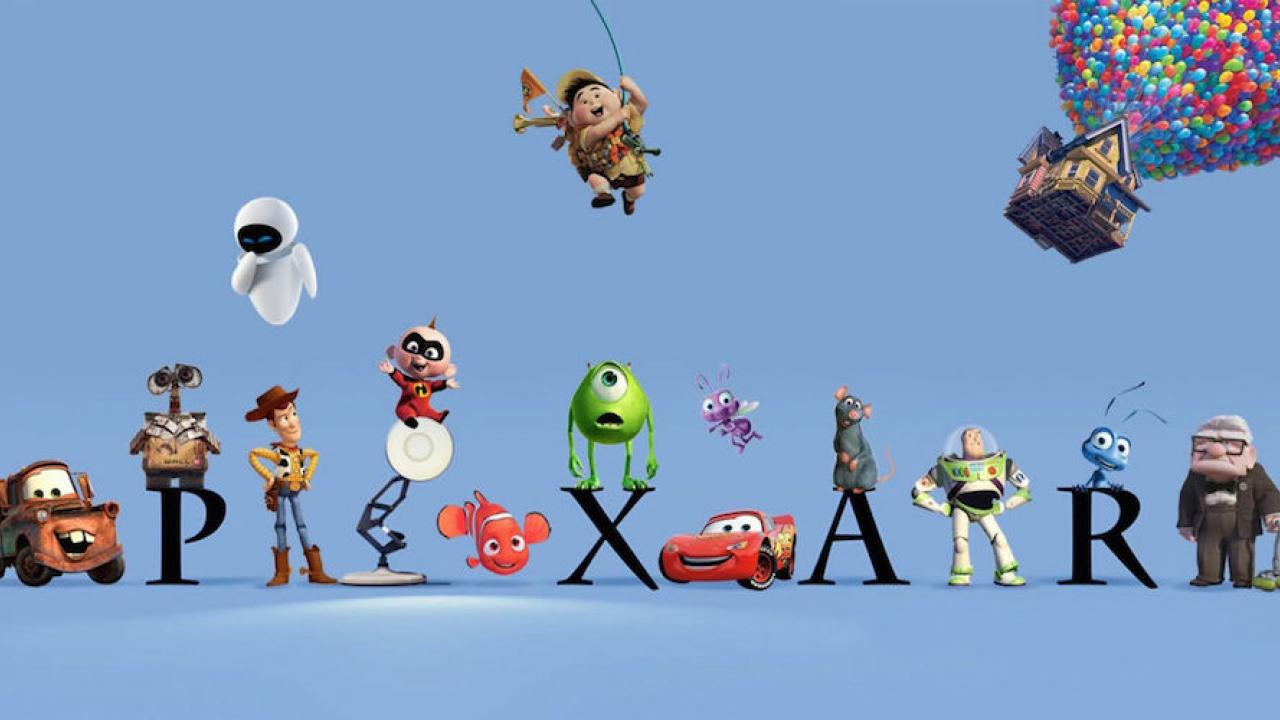
(Source picture: https://www.journaldugeek.com/2019/06/20/le-prochain-projet-pixar-a-deja-un-titre-et-un-synopsis-pour-le-moins-mysterieux/)
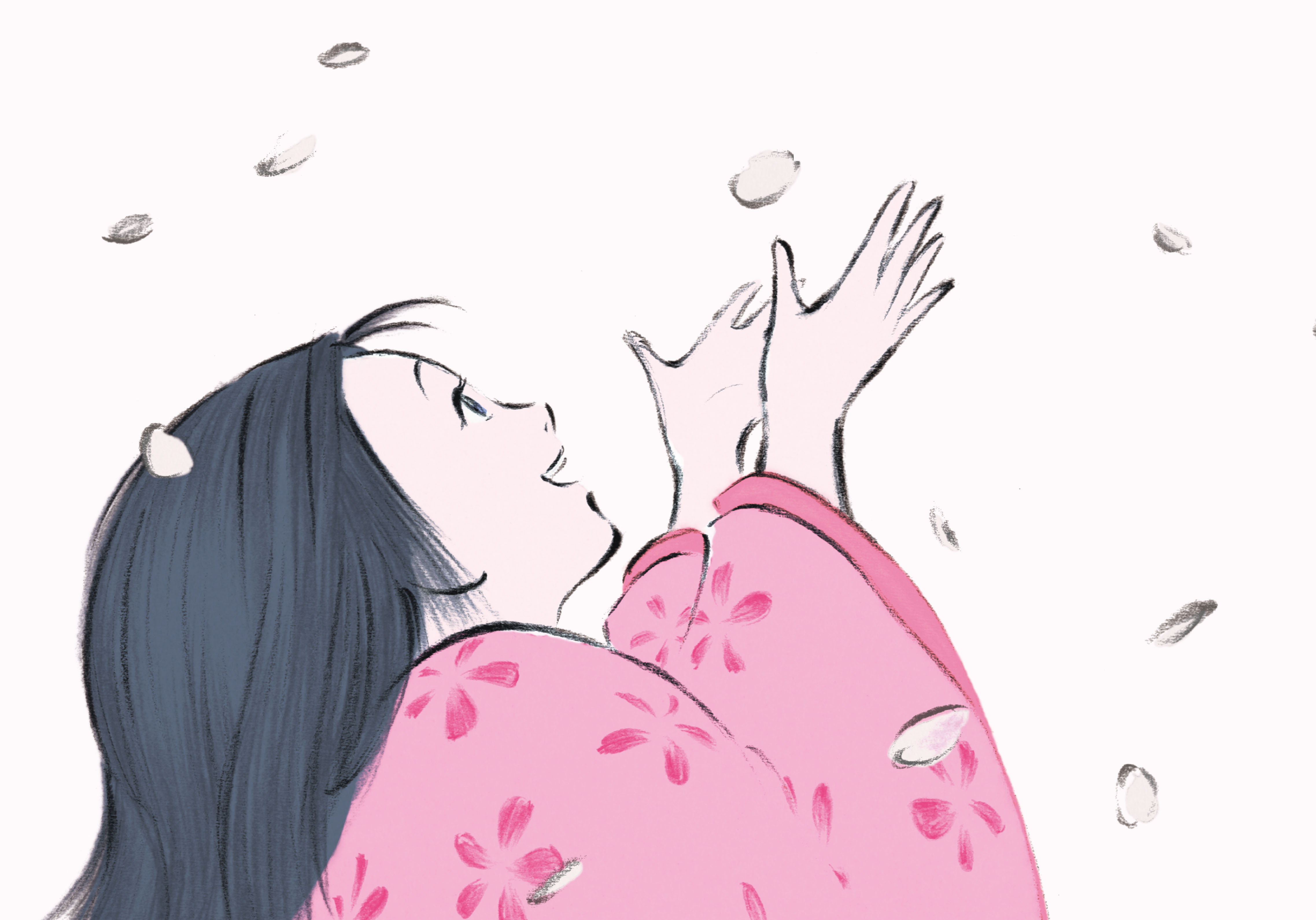
(Source picture: https://entropymag.org/30-years-of-ghibli-the-tale-of-the-princess-kaguya/)
Examining the male side of the story is crucial in order to grasp the whole picture surrounding Studio Ghibli in terms of gender. The Japanese animation studio narrates tales that aren't focused on the typical male-centered heroic storyline, this is in contrast to western animation studios such as Pixar and Disney. Helen McCarthy, author of 'Hayao Miyazaki: Master of Japanese Animation', explains that by choosing a female hero, the macho aspects of heroism are placed out of the picture, resulting in a wider range of possibilities for character development. She states that in this way, Studio Ghibli is exploring heroism. They are removing the stereotypes linked to heroism, reconstructing them and giving the term a refreshing, broader definition. (H. McCarthy, 1999) In addition, professor Ian Condry, a professor of Japanese Cultural Studies at Massachusetts Institute of Technology, writes in his essay on feminism and Studio Ghibli that by dismissing the typical 'good guys' vs 'bad guys' narrative, Studio Ghibli is able to display their characters much more freely. (I. Condry, 2015) \"If it\'s a story like, \'Everything will be fine once we defeat him,\' it\'s better to have a male as a lead. But, if we try to make an adventure story with a male lead, we have no choice other than doing Indiana Jones with a Nazi or someone else who is a villain in everyone's eyes.\", states Miyazaki, co-founder of Studio Ghibli.
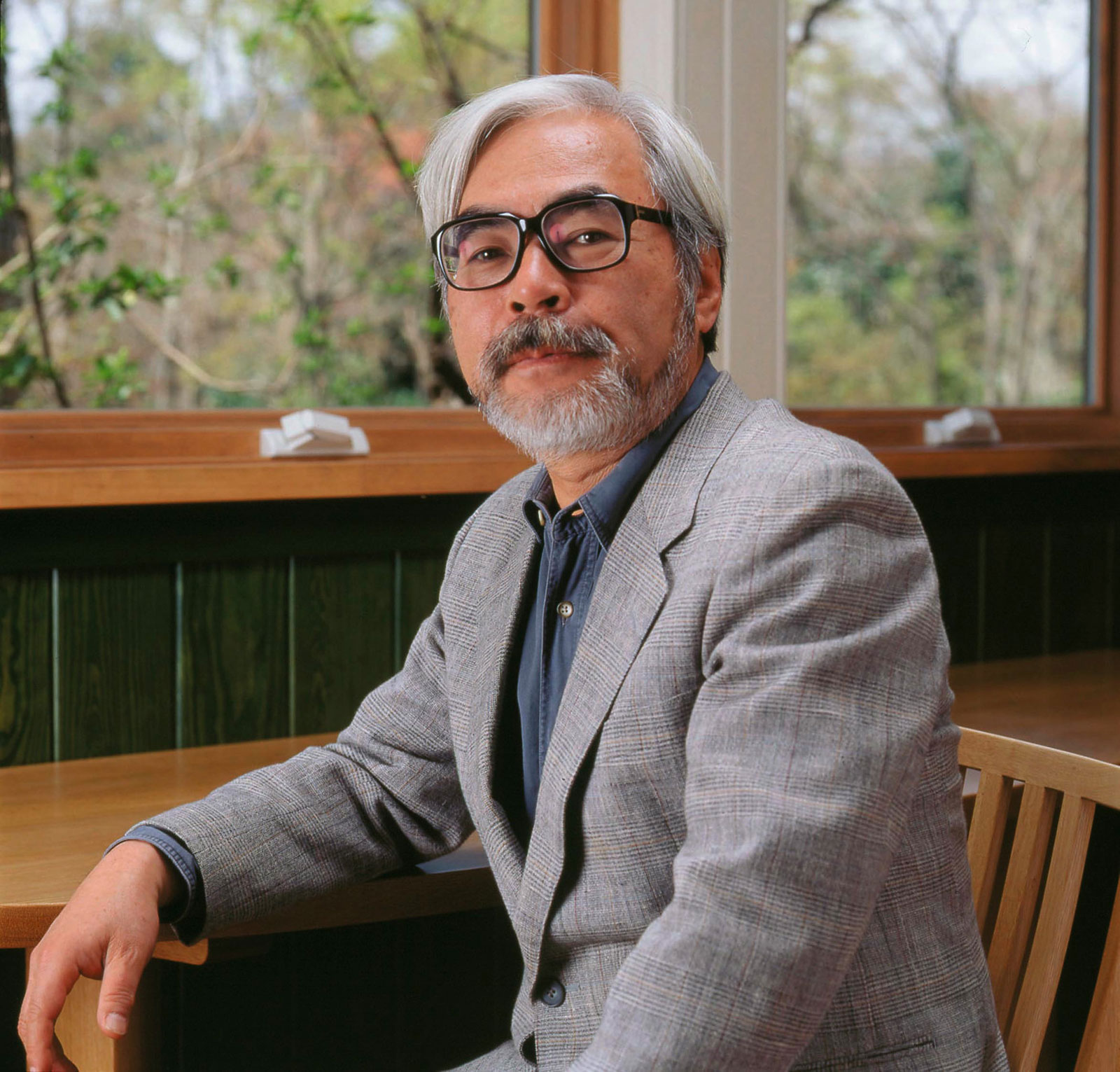
(Source picture: https://www.britannica.com/biography/Miyazaki-Hayao)
The absence of female heroes in animated films influences boys' views on women considerably. Firstly, Disney princess films mainly focus on girls as their target audience. The women in those films can serve as role models for girls growing up. They can mirror themselves and relate to these women in ways boys cannot. However, these sort of films offer no role models for boys to mirror themselves to. On the other hand, male-hero animated films, in which the male-centered heroism is apparent, do offer role models. However, those might only be portraying a stereotypical view on masculinity. They might give young children the impression that they have to be hyper masculine, because that's what they see in their favourite films. This might prevent boys from being their true selves and cause them to put up a macho facade in order to mirror themselves to their favourite heroes. The lack of female heroes might be teaching children that, metaphorically, men have to be the ones to overthrow the villains, preferably with violence. And for that, as a reward, they get the woman. Films have to offer boys a modern-day version of masculinity. They have to offer them (male or female) role models that they can relate to. And that is something that Studio Ghibli delivers. It creates role models for everyone by separating gender from heroism and stepping away from the traditional gender-based roles.
Can we call Studio Ghibli films feminist? Overall, Ghibli films score good on the Bechdel test. However this test does not say whether a film is feminist or not, it simply indicates how women are portrayed in films. What we can conclude is that Ghibli films are without a doubt much more feminist in comparison to western animation films, considering the portrayal of female heroic leads. However the absence of women behind the scenes working on the Ghibli films, such as female directors, is rather disappointing. This lack of women in high level positions at Studio Ghibli suggests the opposite of a feminist workplace. We can conclude that Studio Ghibli is progressive in terms of female representation in their films, but that progress is still needed in their workplace.
References
Alexander E. (2020 February 5). Why Studio Ghibli might just be the most feminist film franchise of all time. https://www.harpersbazaar.com/uk/culture/a30777541/studio-ghibli-feminism-netflix/
Barnett D. (2020, January 27). Studio Ghibli films: An indispensable guide. http://www.bbc.com/culture/story/20200123-studio-ghibli-an-indispensable-guide
Condry I. (2015, December 10). Feminism and Studio Ghibli. 21A.143J / WGS.154J / 21G.591 Gender and Japanese Popular Culture. https://www.studocu.com/en-us/document/massachusetts-institute-of-technology/gender-and-japanese-popular-culture/other/feminism-and-studio-ghibli/844842/view
Beghin C. (2020, March 18). Studio Ghibli: Everything to know about the Japanese animation studio. https://www.vogue.fr/fashion-culture/article/studio-ghibli-everything-to-know-japanese-animation
Dr-Faustus (2017, December 10). Top animated movies: 2000-2020. https://www.imdb.com/list/ls027345371/
Ehrlich D. (2019, June 17). Pixar Vs. Studio Ghibli: Film Critics Pick the World's Best Animation Studio. https://www.indiewire.com/2019/06/pixar-vs-studio-ghibli-best-movies-1202150553/
Perkins J. (2018, June 1). Growing up with Ghibli. https://medium.com/@j.s.perkins/growing-up-with-ghibli-41b0734358f0
Rayne E. (2019, June 17). 9 Fantastical Studio Ghibli characters conjured from Japanese folklore. https://www.syfy.com/author/elizabeth-rayne
Rose S. (2011, July 14). Studio Ghibli: Leave the boys behind. https://www.theguardian.com/film/2011/jul/14/studio-ghibli-arrietty-heroines
Rotten tomatoes. Top 100 animation movies. https://www.rottentomatoes.com/top/bestofrt/top_100_animation_movies/
Verity L. (2015, June 22). The books behind your favorite Studio Ghibli films. https://www.tofugu.com/japan/studio-ghibli-books/